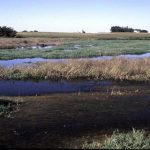Iowa Gov. Terry Branstad joined Iowa Secretary of Agriculture Bill Northey and Director Chuck Gipp from the Iowa Department of Natural Resources and Dr. John Lawrence from Iowa State University to announce the release of the Iowa Nutrient Reduction Strategy for public comment on Monday, November 19, 2012.
“Iowans care about our natural resources and want to protect them for future generations.” Branstad said. “This strategy keeps us at the forefront of using voluntary, science-based practices to improve water quality in our state, and is an important step forward.”
The Iowa Nutrient Reduction Strategy is a science and technology-based approach to assess and reduce nutrients delivered to Iowa waterways and the Gulf of Mexico. The strategy outlines voluntary efforts to reduce nutrients in surface water from both point sources, such as wastewater treatment plants and industrial facilities, and nonpoint sources, including farm fields and urban areas, in a scientific, reasonable and cost effective manner.
The Iowa Department of Agriculture and Land Stewardship, Iowa Department of Natural Resources (DNR) worked with Iowa State University over a two-year period to develop the strategy. The resulting strategy is the first time such a comprehensive and integrated approach addressing both point and nonpoint sources of nutrients has been completed.
The Iowa strategy has been developed in response to the 2008 Gulf Hypoxia Action Plan that calls for the 12 states along the Mississippi River to develop strategies to reduce nutrient loading to the Gulf of Mexico. The Iowa strategy follows the recommended framework provided by EPA in 2011 and is only the second state to complete a statewide nutrient reduction strategy.
“The strategy’s science assessment provides a research-based foundation to quantify the effectiveness of current practices for reducing nutrient losses from the landscape,” said John Lawrence, associate dean for extension and outreach programs in ISU’s College of Agriculture and Life Sciences and director of ISU Agriculture and Natural Resources Extension. “The assessment reflects two years of work to evaluate and model the effects of the practices by scientists from ISU, IDALS, DNR, USDA Agricultural Research Service, USDA Natural Resources Conservation Service and other institutions.”
Iowans are invited to review the strategy and provide feedback during a 45 day comment period that starts today and will end on January 4,2013. The full report, additional information and place for comments can be found at www.nutrientstrategy.iastate.edu.
In addition, presentations will be made to farmers, certified crop advisors and others in the agriculture industry as part of ISU Extension and Outreach educational meetings beginning this fall. Thousands of people will learn of the strategy, where to find more information and how to provide comments about it.
Point Sources (DNR)
The Iowa Department of Natural Resources will be working with major facilities throughout the state to reduce nutrient discharges from point sources to Iowa’s waters with a goal of reducing total phosphorus by 16 percent and total nitrogen by 4 percent.
“The DNR has been working with the Iowa Department of Agriculture and Iowa State for nearly two years and support this strategy document and the collaborative process that created it. Many Iowans enjoy our state’s natural resources and it important we protect them for future generations,” Gipp said.
Nonpoint Sources
To address nutrient transport from nonpoint sources the strategy uses a comprehensive, first of its kind scientific assessment of conservation practices and associated costs to reduce loading of nutrients to Iowa surface waters. The strategy identifies five key categories to focus the efforts in addressing nonpoint sources and identifies multiple action items within each category.
The five categories are: Setting Priorities; Documenting Progress; Research and Technology; Strengthen Outreach, Education, Collaboration; and Funding.
By harnessing the collective innovation and capacity of Iowa agricultural organizations, ag businesses and farmers the strategy takes a significant step forward towards implementing practices to improve water and soil quality.
“This strategy provides the most up-to-date scientific information available to farmers as they seek to use the best practices available to reduce nutrient delivery from their farm,” Northey said. “The goal of this strategy is to get more conservation practices on the ground. This is not about rules or regulations, instead this strategy provides resources to farmers to help them improve water quality.”


